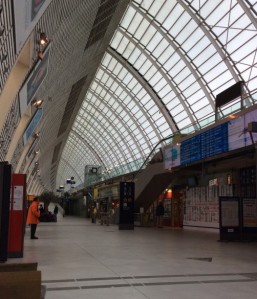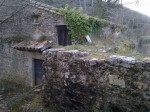For days before we left for France I was quietly humming “sur le pont d’Avignon l’on y danse, l’on y danse…” The jaunty tune reflected my hopes: I anticipated warmth and sun, olive oil and herbed salt, the slow pace of life as it was meant to be lived before economic globalization. And I was curious. Why did writers seek out this corner of France? I was thinking mainly about Canadian writers who lived in or near Provence or had done: Timothy Findley, Tomson Highway, Isabel Huggan, Nancy Huston, Michael Ignatieff, Alberto Manguel, Jeremy Mercer*, Emma Richler, and on short visits, Gabrielle Roy. That’s not counting all the ones who’ve lived in Paris and elsewhere in France, or the authors I don’t know about.
It still delights me that TGV means “the train that goes really fast” (Train à Grande Vitesse). London to Paris by Eurostar, Paris to Avignon by TGV. Don’t do this: arrive after dark, when everything in the station is closed. Walk on empty sidewalks in the rain to the hotel nearest the station (nearest to does not mean near to). Discover that the hotel reception is closed, and the hotel door is locked.
The TGV station in Avignon is in the middle of nowhere. I thought all land in Europe was occupied and that there couldn’t be a middle of nowhere, but we’d found it. The shuttle train into town left only every half hour. By the time we got into the hotel (cell phone) and dumped our stuff, we were hungry enough to forego a trip into town for a fine French meal and settle instead for a walk to some junk food. Our first meal in France was at a hamburger joint under an overpass, a place so busy that the line-up took half an hour; every customer had a five minute chat with the cashier, as if they had never ordered fast food before, as if asking for recommendations for culinary pairings. But fascinating. The crowd of young adults all seemed to know each other and didn’t mind that no alcohol was served; it put me in mind of a film scene of a 1950s soda bar.
So far not as anticipated. But oh, the next morning, surely Avignon will make it all better. On the shuttle into town we discussed how the graffiti in the train yards was an antithesis to the sleek chic design of the TGV and its station. Through the rain we walked toward the Palais des Papes, laughing at the weather, eager to see the 14th century palatial fortress. Up went my umbrella as we went from old section to “new” palace, down it went as we moved from chill grey stone chamber to intimidating banquet hall to the more intimate bed chamber. Dawdling to take in the audio, video and plaque information, peering into the other world of frescoes, delighting in the secret below-floor treasury. Tout à coup, there was only time for a quick bite — no time left to walk across Avignon to see the pont. And anyway half the pont is missing, washed away, and it isn’t even called the Pont d’Avignon but the Pont Saint-Bénezet, and … maybe we would dance on it when we came back to catch the return train.
Anxious not to arrive at Le Mas Blanc in the dark, we shuttled back and picked up the rental car and hit the road for Anduze. And discovered that last night was not an anomaly. Avignon, as were many of the towns we visited, was skirted by single story box stores of the sort one expects in the suburbs of any Canadian town: car dealers, mattress stores, tire and motor repair shops, overgrown hardware stores, gardening stores, strip malls with pizza places and chain clothing shops.
From Avignon to Le Mas Blanc by AutoRoute was only two hours. We were rushing to see Isabel Huggan and to stay two nights in the writing studio at Le Mas Blanc. I can now enthusiastically endorse both writing studio and Isabel Huggan’s close reading of one’s work. And there, in the grey rain of early evening, was everything I wished for while humming that tune: olive trees, gardens, fragrant ground cover, birds, a well-maintained old stone farmhouse, a roast chicken stuffed with herbs, and a warm fire in Isabel’s living room. The next day, when the rain paused, we took a walk around the vineyards and also saw the grounds of the 12th C Romanesque church, St Baudile.
Then off we went to stay with Montreal friends who live near Apt. Much they had to show us, taking us to abbeys and priories, markets and towns, the Joseph Sec monument, La Tour d’Aigues, along the route of Cezanne (where we were caught in a traffic jam). Pausing over small fields of lavender that were squeezed between the sprawl of new houses, they assured us that next month lavender would be purple and the cherry trees would be in white blossom. We drove slightly out of our way to see various stone igloos (bories) that sheltered shepherds in the fields. And in Aix-en-Provence we did have that fine French restaurant meal, and at their place, salads so fresh they could’ve been plucked from the garden just then, and more delicious home cooking. My strange dietary needs were even met on the cheese tray.
In one of many interesting conversations about history and land formations and stone cladding and terrorism and Tunisia and politics and children and shopping and books, someone used the expression “fait le pont.” Snap – back my mind went to our daughter’s elementary school days in Vienna, when French families took as a holiday the school day that fell between a holiday and a weekend – bridged the gap to make a four day weekend. They would “fait le pont” and zoom off to that romantic France from which they could not bear to be parted.
“Sur le pont d’Avignon l’on y danse tout en rond.” I never did dance on the bridge, or even step on it. Did I even want to? I was too busy with my own version of “fait le pont” — bridging the gap between the imagined and the real, the anticipated and the actual, the past and the present.
*Forthcoming: interview with Jeremy Mercer





My, your posts are getting better and better and better; although they were always very interesting and wonderful but now it seems that you’ve hit a new peak. I think you’ve found your true calling. Your descriptions are so rich and varied and interesting….
>
LikeLike
Matt Cohen and his family spent some time living in France during the early 90s, where he wrote while his wife, Patsy Aldana, still ably ran Groundwood Books via fax and phone. (I was one of her sales reps at the time.)
LikeLike
Thanks! Anyone else want to add to the list?
LikeLike